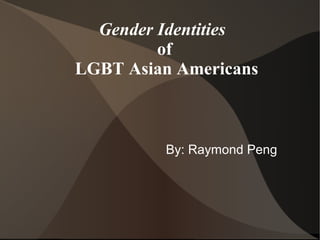Asian lgbt gender presentation
- 1. Gender Identities of LGBT Asian Americans By: Raymond Peng
- 2. Outline ŌŚÅ Struggles ŌŚÅ Gay Men ŌŚÅ Lesbians ŌŚÅ Bisexuals ŌŚÅ Transgenders ŌŚÅ References
- 3. Struggles ŌŚÅ Invisibility ŌŚÅ Racialized stereotypes ŌŚÅ Genderized biases ŌĆō Nadal, K. L., & Corpus, M. H. (2012)
- 4. Struggles ŌŚÅ Asian and Pacific Islander gays, lesbians, and transgender individuals share problems of invisibility. Many of them are under-represented in the media or the literature. ŌŚÅ To compound on this situation, racialized and gendered stereotypes in hetero-centric communities make representation of Asian/Pacific LGBT communities even more difficult.
- 5. Gay Asian American Men ŌŚÅ For gay Filiipino Americans, religion acts as a major hindrance to coming out. ŌŚÅ Many reported that their parents believe homosexuality is morally wrong according to their interpretation of the Catholic teachings.
- 6. ŌŚÅ Many also stated conflicting relationships with religious family members ŌŚÅ Putting family first before their feelings
- 7. Gender Norms ŌŚÅ Males need to be masculine and dominant. ŌŚÅ Males reported families often reprimanded them for gender variant mannerisms or style of dress. Male members frequently talked about how their parents corrected their body movement.
- 8. Gender Norms ŌŚÅ Straight acting vs Femme ŌŚÅ Asian men are emasculated as "asexual" or "feminine" ŌŚÅ Althought stigmatized, Asian men are often expected to continue acting feminine.
- 9. Gender Norms ŌŚÅ Gay Asian American men perceived as being submissive and mostly viewed as "bottoms." ŌŚÅ Any displays of feminine mannerisms on television by gay characters would be laughed at, as their roles are generally comical and frivilous.
- 10. Femininity ŌŚÅ Asian American women with curvy bodies associated more with white women than with Asian American women. ŌŚÅ Asian American women's bodies are perceived as non-shapely and less desirable. ŌŚÅ Many desire white femininity.
- 11. Asian Lesbian ŌŚÅ Chinese lesbians are called lalas ŌĆō many of which live "dual lives." They may be married to a man, but are only attracted to women sexually. ŌŚÅ A woman in a same-sex relationship may not identify as lesbian or aim for egalitarianism in gender roles as commonly seen in Western lesbian relationships (Wieringa et al., 2007).
- 12. Bisexuals ŌŚÅ Findings from the National Latino and Asian American Survey (NLAAS) indicated that bisexual men were more likely than heterosexual men to report a recent suicide attempt. ŌŚÅ Among women, lesbian/bisexual women were more likely than heterosexual women to evidence positive 1-year and lifetime histories of depressive disorders.
- 13. Transgender ŌŚÅ Many are comfortable with the label Gender Identity Variant. ŌŚÅ Many Asian trans individuals begin cross-gender presentation and physical transition around their teens or even before. ŌĆō (Winter, 2009)
- 14. Statistics ŌŚÅ There are approximately 100,000 Malaysian transwomen. (Jamaludin, 2001; Kaur, 2007) ŌŚÅ In India there are an estimated 500,000 Indian transwomen (Nanda, 1990) ŌŚÅ In Thailand there are perhaps 300,000 transwomen around 1:300; (Winter, 2002)
- 15. Adaptive factors ŌŚÅ Trans individuals living in Asia face are more accepted than ones in Western cultures. ŌŚÅ Growing up in cultures of gender pluralism ŌŚÅ Traditions of transpeople performing highly valued social roles (e.g. spirit mediums and healers)
- 16. ŌŚÅ Family of choice is a significant factor in their transition. ŌŚÅ Many transpeople chooses to live in communities where they can usually find a ready source of emotional and social support, as well as practical information (including on medical matters) to guide them through their transition process.
- 17. References ŌŚÅ Nadal, K. L., & Corpus, M. H. (2012). ŌĆ£TomboysŌĆØ and ŌĆ£BaklasŌĆØ: Experiences of Lesbian and Gay Filipino Americans. Asian American Journal Of Psychology. ŌŚÅ Jamaludin, F. (2001, January 21). Transsexuals: Declare us as women. The Star. Retrieved November 29, 2012, from http://ai.eees.umich.org/TS/MalaysianTS.html ŌŚÅ Kaur, J. (2007, June 15). Mak Nyah Cry for Compassion. Bernama. Retrieved Oct 29, 2012, from http: / / sgbutterfly.org/ index.php? Name=News&file=article&sid=218. ŌŚÅ Kim, H. (2006). Asianized Asians, Twinkies, and North Face Puffy Jackets: Constructing Racialized Gender Identities among Second Generation Korean American College Women. Conference Papers -- American Sociological Association, 1. ŌŚÅ Nanda, S. (1990). Neither man nor woman: The Hijras of India. Belmont, CA: Wadsworth. ŌŚÅ Winter, S. (2002). Counting kathoey. Retrieved September 7, 2005, from http://web.hku.hk/Ōł╝sjwinter/TransgenderASIA/paper counting kathoey.htm ŌŚÅ Winter, S. (2006). Thai transgenders in focus: Demographics, transitions and identities. International Journal of Transgenderism, 9(1), 15ŌĆō27.

















